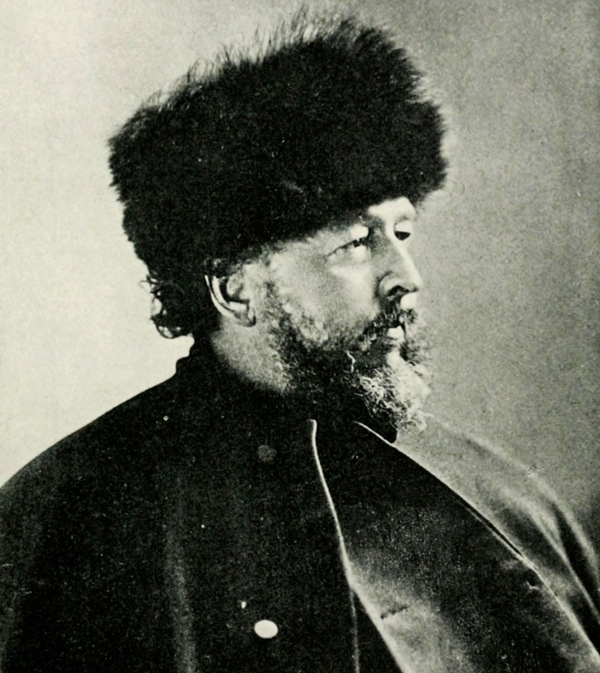Bayard Taylor’s “Sicilian Wine” is an accolade to the Italian island, through its “crimson” reds. A glimpse into Taylor’s adventurous life paired with a terrific red from the Etna volcano
A true wine lover possesses the quintessential traveller soul. The more I delve into wine and its intricacies, the more the previous statement appears truthful to me. Wine is so intertwined with geography, traditions and places that it is virtually impossible to fully appreciate this complex beverage if you ignore where it comes from.
I’m not talking about the occasional sippers, or bibulous people getting intoxicated during the weekend to forget their Monday to Friday routine. Real wine lovers appreciate the nuances of their drink and moderately savour it, never disregarding the true soul of their beloved wine – its origin. In this sense, wine lovers are travellers.
Wine lovers may not physically wander from vineyard to vineyard. They may not travel through exotic wine regions or visit remote cellars. Nonetheless wine lovers will always have the curiosity to discover where the bottle comes from, namely the places and the people involved.
Some people (the type I romanticise) are actually born with the traveller soul. Among those, undoubtedly Bayard Taylor deserves mention. He also happened to be a wine lover according to my definition above. In 1854 he wrote the poem Sicilian Wine, an intense and voluptuous praise of red wines coming from Sicily’s Etna mountain. Below is the full version of this poem.
I’ ve drunk Sicilia’s crimson wine!
“Sicilian Wine”, James Bayard Taylor
The blazing vintage pressed
From grapes on Etna’s breast,
What time the mellowing autumn sun
did shine:
I ‘ve drunk the wine!
I feel its blood divine
Poured on the sluggish tide of mine,
Till, kindling slow,
Its fountains glow
With the light that swims
On their trembling brims,
And a molten sunrise floods my limbs!
What do I here?
I ‘ve drunk the wine,
And lo! the bright blue heaven is clear
Above the ocean’s bluer sphere,
Seen through the long arcades of pine,
Inwoven and arched with vine!
The glades are green below;
The temple shines afar;
Above, old Etna’s snow
Sparkles with many an icy star:
I see the mountain and its marble wall,
Where gleaming waters fall
And voices call,
Singing and calling
Like chorals falling
Through pearly doors of some Olympian hall,
Where Love holds bacchanal.
Sicilian wine! Sicilian wine!
Summer, and Music, and Song divine
Are thine, — all thine!
A sweet wind over the roses plays;
The wild bee hums at my languid ear;
The mute-winged moth serenely strays
On the downy atmosphere,
Like hovering Sleep, that overweighs
My lids with his shadow, yet comes not near.
Who ‘11 share with me this languor?
With me the juice of Etna sip?
Who press the goblet’s lip,
Refusing mine the while with love’s enchanting
anger?
Would I were young Adonis now!
With what an ardor bold
Within my arms I ‘d fold
Fair Aphrodite of Idalian mould,
And let the locks that hide her gleaming brow
Fall o’er my shoulder as she lay
With the fair swell of her immortal breast
Upon my bosom pressed,
Giving Olympian thrills to its enamored clay!
Bacchus and Pan have fled:
No heavy Satyr crushes with his tread
The verdure of the meadow ground,
But in their stead
The Nymphs are leading a bewildering round,
Vivid and light, as o’er some flowering rise
A dance of butterflies,
Their tossing hair with slender lilies crowned,
And greener ivy than o’erran
The brows of Bacchus and the reed of Pan!
I faint, I die:
The flames expire,
That made my blood a fluid fire:
Steeped in delicious weariness I lie.
O, lay me in some pearled shell,
Soft-balanced on the rippling sea,
Where sweet, cheek-kissing airs may wave
Their fresh wings over me;
Let me be wafted with the swell
Of Nereid voices; let no billow rave
To break the cool green crystal of the sea.
For I will wander free
Past the blue islands and the fading shores,
To Calpe and the far Azores,
And still beyond, and wide away,
Beneath the dazzling wings of tropic day, .
Where, on unruffled seas,
Sleep the green isles of the Hesperides.
The Triton’s trumpet calls:
I hear, I wake, I rise:
The sound peals up the skies,
And mellowed Echo falls
In answer back from Heaven’s cerulean walls.
Give me the lyre that Orpheus played upon,
Or bright Hyperion, —
Nay, rather come, thou of the mighty bow,
Come thou below,
Leaving thy steeds unharnessed go!
Sing as thou wilt, my voice shall dare to follow,
And I will sun me in thine awful glow,
Divine Apollo!
Then thou thy lute shalt twine
With Bacchic tendrils of the glorious vine
That gave Sicilian wine:
And henceforth when the breezes run
Over its clusters, ripening in the sun,
The leaves shall still be playing,
Unto thy lute its melody repaying,
And I, that quaff, shall evermore be free
To mount thy car and ride the heavens with thee!
Who was Bayard Taylor?
James Bayard Taylor was born in 1825 in Pennsylvania, USA. From a young age, he was an avid reader and restless student. Taylor’s poetic career started in 1844, when he published his first volume of poetry: Ximena, or the Battle of the Sierra Morena, and other Poems. The work served as a forerunner for his role at the prestigious newspaper, The New York Tribune, as a journalist and travel writer.
In the following years, Taylor explored Europe visiting England, France, Germany and Italy. Taylor was a frugal traveller. Most of his itineraries were purely by foot. In two years he only spent £100 in travel expenses but he collected a vast amount of interesting stories. Taylor regularly sent his accounts back to the The New York Tribune. When he returned to the USA in 1846, he was asked to put his adventures across Europe into book form.
However, Taylor’s time as a traveller was far from concluded. After a few years, he travelled west to recount the notorious California Gold Rush. He then travelled to Mexico (his stories were collected into a successful book of travels, entitled El Dorado), Egypt, England (again), Russia, Palestine, Asia Minor, India, China, Japan. Taylor was truly considered a modern Marco Polo. His numerous journeys resulted in a multitude of poems and novels, most of them acclaimed by the general public.
Taylor travelled until his very last days. Late in life, he decided to study the history and culture of Northern Europe, travelling across Sweden and Iceland. He died in 1878 in Berlin, where he had held the office of a United States Minister.

The poem
The verses of Sicilian Wine are filled with a vivid imagery. Probably influenced by the free verses of Walt Whitman and/or Germanic Romantics (Taylor translated some German classics, most notably Goethe), Bayard Taylor’s poem portrays the wine of Sicily with the same features of the Mediterranean island itself. The reader can almost see the snow-clad peak of the Etna volcano, its dramatic presence dominating the landscape. The images appear striking and saturated, exactly like the colours of Sicily under the scorching sun of a summer day. The wine is “crimson” red, the sky is “bright blue heaven”. The sea is “green crystal”. Nature itself is impetuous. The verses are packed with powerful natural elements: the volcano, the whipping wind, the flames, the intense sun.
The numerous echoes of Greek mythology in Taylor’s poem constitutes another bow to Sicily’s long history. Ancient Greeks colonised the island in the 8th century BC. The region represented the heart of Magna Graecia (Greater Greece), the outpost that exported Hellenic civilisation to Southern Italy. Incidentally, the Greeks likely brought viticulture in Sicily – another reason to praise them!
Overall, it seems to me that Sicilian Wine is a praise to the wines from the island and the island itself. The fascinating historical heritage of Sicily, along with its breathtaking natural beauties and landscapes, clearly moved Bayard Taylor’s traveller soul. So much that he felt compelled to dedicate a poem to this Mediterranean island.

Which wine conveys the intensity, complexity and fierceness of Sicily? What wine allows the drinker’s every sip to feel the “blood divine” poured on their soul? Loads of Sicilian wines can produce that effect. Here I chose one wine, from the Etna (as the poem indicates) to represent the spirit of the island as imagined by Baylard Taylor.
The proposed wine is called Sul Vulcano (“On the volcano”) by Donnafugata, one of the most noteworthy names in the Sicilian wine revolution. The wine name perfectly fits Bayard Taylor’s poem. The top of the volcano “where sweet, cheek-kissing airs wave their fresh wings over me” seems an impeccable place to enjoy the vivid sensations emanated by these verses. And to enjoy this vivacious wine!
Donnafugata - Sul Vulcano Etna Rosso, 2016

 Country: Italy
Region/appellation: Sicily - Etna DOC
Wine style: Dry red - Savoury and Classic
Grape(s): Nerello Mascalese
Average price: £25
Country: Italy
Region/appellation: Sicily - Etna DOC
Wine style: Dry red - Savoury and Classic
Grape(s): Nerello Mascalese
Average price: £25
Donnafugata estate was founded by the Rallo family in 1983 but this Sicilian family has been making wine since the mid-nineteenth century. In a period where bulk wine exportation was the norm, Donnafugata was one of the first winemakers to start a culture of high-quality wine on the island.
Today, Donnafugata owns a total of 405 hectares over five estates situated in different districts in Sicily. They export a broad range of wines to 60 countries using 20 different grape varieties.
The name Donnafugata means “fleeing woman”. It is a reference to Queen Maria Carlonia, who escaped the court of Naples in the early 19th century with her husband, Ferdinand IV of Bourbon after the arrival of Napoleon’s troops. The couple took refuge at a site which is today one of Donnafugata’s vineyards. The name Donnafugata also appears in the famous “Gattopardo” (The Leopard) novel by Tomasi di Lampedusa.
Donnafugata’s logo consists of the head of a woman with windblown hair. The trademark appears on every bottle of Donnafugata’s wine. All the labels feature artworks by Gabriella Rallo. In her art, she portrays feminine figures immersed in a dream-like and serene atmosphere.
Tasting notes
(tasted on: 02-Mar-2019)
The wine appears light ruby, almost garnet-like, in the glass. To the nose, this red has pronounced intensity of flavours both fragrant and aromatic. A rich and intense fruitiness combines with layers of spices, exhibiting a superb elegance. Wild red cherry, strawberry and red currant notes give way to the spicy undertones of earth, undergrowth, and musk. There are also reminiscences of violets and rose with a touch of black pepper. Oak is used with parsimony. The wood integration is seamless, revealing hints of nutmeg, cinnamon and a subtle toastiness around the edges. A discreet presence of herbal spices is also noticeable – sage, rosemary, mediterranean shrubs.
On the palate, the wine is intense in flavours, with medium body and a perfect high acidity that makes the wine lively and crisp. A zesty elegance traverses the palate from start to end. The red fruit aromas are slick, crunchy and juicy. The tannins (medium+ in level) are ripe, silky and fine-grained. A refined spiciness merges with hints of cinnamon, nutmeg, juniper, earth, and a nuanced toastiness. A flinty minerality lifts the whole aromatic profile; a characteristic common to the best wines from Etna. Long earthy finish, terminating with a savoury dry note. Overall this is a fantastic Nerello, with freshness, huge finesse and precision.
Wine and other Stories rating: 9.3/10

